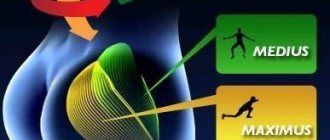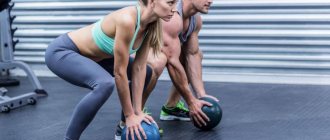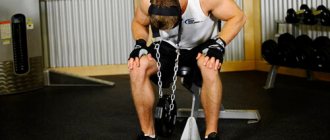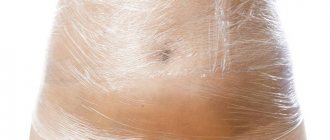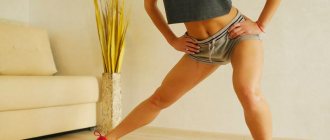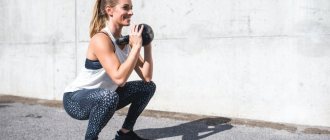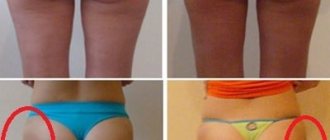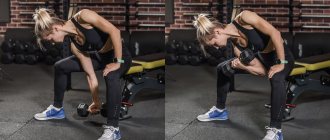Beautiful forms have always delighted and attracted others. And for a girl, one of the important parts of the body is elastic, toned buttocks. You can make them exactly like this through exercises designed for this part of the body. You can go to the gym, but if this is not possible, you can cope with the task of tightening your butt at home. The main thing is to choose the right exercises for this, which we will discuss below.
Basic rules
If you want to tighten your buttocks, then you need to perform exercises 3-4 times a week. It is also important to eat right and maintain a healthy lifestyle in general.
For home exercises, you will need a fitness mat and comfortable sportswear. Also, dynamic music will not be superfluous, it will be more fun to practice with.
Most often, exercises that work the buttocks also work the upper thighs, lower back, and other muscles. So, by working on your main goal, you can improve the condition of your entire figure as a whole.
Before you start doing exercises, be sure to warm up your major muscle groups. To warm up, you can use fast walking in place, bending, and turning. Once you finish it, move on to the main exercises.
Hip enlargement program
To acquire the desired shape, diligence and regular exercise are required. A properly selected program will allow you to build muscle mass in the right places and make narrow hips wider.
General recommendations include:
- mastering the correct exercise technique;
- performing movements slowly to ensure maximum muscle tension;
- gradually increasing the load using dumbbells or other suitable loads;
- selection of the optimal diet for increasing muscle volume.
If desired, a girl can work out in the gym under the guidance of an instructor or increase her hips at home.
How to tighten your butt at home quickly: exercises
There are a large number of exercises aimed at tightening the buttocks and thighs. We offer an effective complex that involves classes three times a week (the first day is Monday, the second day is Wednesday and the third is Friday.
First day
Exercise 1 – squats
Squats are one of the most effective exercises that help tighten the lower part of the buttocks and also work the thighs well.
The starting position is as follows: your feet should be placed shoulder-width apart or slightly wider. Toes should point outward at an angle of no more than 45 degrees. The knees should be in the same plane as the feet. Do not bend them or move them excessively in the opposite direction. Your hands can be placed on your belt, straightened in front of you, or spread to the side. You need to breathe evenly. Inhale the air, squat down. Then, while exhaling smoothly, return to the starting position.
Your back should be straight when performing exercises. It is recommended to do 3-5 sets of 10-15 repetitions. Increase the load over time.
Exercise 2 – lunges
Lunges strengthen the buttocks, back and inner thighs. Doing them regularly will help remove cellulite from the gluteal muscles.
You need to stand up straight, put your feet shoulder-width apart, place your hands on your belt. Place your right leg as far forward as possible, squat down on it, while the knee of your left leg should not touch the floor. Shift the weight of your body to your right leg, and begin to pull your left leg towards you. When your legs are together, return to the starting position and change legs.
Do three sets, 10-15 repetitions on each leg.
Exercise 3 – glute bridge
An excellent exercise to tighten your butt and buttocks. You need to lie down on the mat. Lying on your back, bend your knees, spread your arms to the sides. Lift your pelvis up so that your back is straight. In this case, you need to lean on your legs and shoulders. Then slowly return to the starting position. This exercise perfectly works the gluteal muscles.
Do 3-5 sets of 10-20 repetitions.
Second day
Exercise 1 – swings
You need to lie on your side, your right hand should support your head, resting your elbow on the floor. Place your left hand on your waist. Now do the swings: lift your left leg up 90 degrees and slowly lower it. Do this 20-25 times . Then roll over to the other side and repeat the same with the other leg. So, do 3-5 sets for each leg.
Exercise 2
Get on all fours, lower yourself onto your elbows. Keep your back straight. Straighten one leg and swing it up and down, 20-25 repetitions for each leg. For both legs, do 2-5 sets. To increase efficiency, it is recommended to use leg weights.
Exercise 3
Get on all fours. Lift your right leg up, as in the previous exercise, then move it to the right. Using a circular motion, return your leg to the starting position, then switch legs.
Do 3-5 sets of 20-25 reps.
The third day
Exercise 1
This exercise is useful for those who want to quickly tighten their buttocks and also remove the “ears” on the hips. You need to stand up straight, place your feet shoulder-width apart. On the count of “one,” you need to bend your right leg at the knee and touch it with the elbow of your right hand. The left arm should be raised above the head. Without lifting the heel of your left foot, stretch your left arm over the top to the right. It should look like you are a tree leaning to the right. This pose is static, that is, you must freeze in it for some time. Then return to the starting position and repeat the same for the other side.
Perform 3-5 sets of 15-20 repetitions.
Exercise 2
The starting position is the same as in the previous exercise. Shift your body weight to your left leg and take your right leg back. Keep your hands on your belt, your back should be straight. Now try to raise your right leg as high as possible while maintaining balance.
If you find it difficult to maintain balance, you can lean on a wall or hold on to a chair. Change your leg. If you want to make it more challenging, use leg weights.
Do three sets of 10-15 repetitions.
Exercise 3
You need to lie on the floor with your stomach down. Bend your legs at the knees. Place your hands along your body, palms down. From this position, arching your back, try to lift your legs off the floor as much as possible. Hold for a few seconds in the upper position and lower them down.
Perform three sets of 20-30 reps.
Also be sure to include cardio exercise in your program: running, dancing, cycling, and so on. They also perfectly tighten the butt and promote uniform weight loss.
How long does it take to tighten your buttocks? Everything is individual, however, you will notice the first results after a month of regular exercise.
Core thigh muscles
Psoas. What we always briefly refer to as the psoas muscle is actually a group of muscles that basically runs from the spine through the hips to the thighs. However, for the sake of simplicity, we will focus on the “psoas muscle.” This is a large hip flexor that, in a tight form, pulls the hip toward the upper body (for example, when you are sitting). If you stretch your leg back, you get a stretch of the psoas muscle. It begins in the lower thoracic spine, then descends into the pelvis and ends at the femur. This is the only muscle connecting the spine to the legs. Only through it can we stand upright and raise our legs while walking. Provides stability and balance.
The psoas muscle is also connected to the diaphragm through the fascia. Since the breathing and fear reflexes are triggered here, the lumbar muscle is directly affected. She tenses up and prepares for a quick escape or fight. If we constantly activate the psoas muscle through stress and tension, we increase muscle tension and even chronic tightness. It is often the cause of back pain, sciatica, knee pain, as well as menstrual cramps or digestive problems. It also puts pressure on the nerves and thus causes painful movement. Car seats, office chairs and our sofa are her worst enemies.
Moreover, if the psoas muscle is not completely relaxed, we will not be able to perform many asanas properly. Therefore, relaxation is one of the most important disciplines in yoga. Movement is truly only possible through relaxation, even in strenuous exercise.
Piriformis muscle. A muscle that is located in the buttocks and is hidden under the gluteus maximus muscle. The piriformis muscle is a small, often unnoticed muscle that can quickly attract attention if it is blocked. The sciatic nerve runs underneath it, and when the piriformis muscle spasms, it puts pressure on this nerve. This is often mistaken for a herniated disc and leads to improper treatment. You should not wait for the pain to go away on its own. Such compression can become chronic. And if the nerve is irritated, it may take a long time for it to become painless.
The hip from a yoga perspective. So, hip-opening asanas work at the epicenter of your body. From a yoga perspective, it is often said that emotions, stress and tension are stuck here or can be felt. The better flexibility achieved by stretching the hips and the dedication this asana requires also has a positive effect on emotional sensations.
The hips also affect the shoulders, knees and jaws. Therefore, tightness in the hip can also indicate problems in other areas and vice versa. A tense jaw often causes tension in the hips. Therefore, relaxation plays a big role when we practice asanas, which are supposed to stretch the thigh muscles and thus relax.
Misconception: “Anyone can do the lotus pose with enough practice.” It is widely believed that with enough stretching, asanas such as the lotus pose are possible, and so hardworking yogis practice their padmasana. But anatomically, some people simply cannot bend into a pretzel. To assume the lotus position, you need to be very mobile. If the body is not yet well stretched, the muscles of the back of the thighs or the lumbar spine are shortened, you should feel the limits of possible tension and compression, and slowly, carefully practice asanas.
A sign that you're not ready (yet) is often when your knees don't touch the floor on their own in a cross-legged sitting position. Often the knees are pressed to the floor, and the pose can only be maintained with great pressure or effort. This can cause knee and meniscus injuries. If the pose is forced, then this mainly occurs due to the knee joints. And the full lotus is not the only asana that should be performed with caution; injuries can also occur with other extreme hip opening exercises. So there's no shame in using the tools and delving into only what works for you. This is also a good way to get rid of the ego. Because nothing else is the yogic desire for the ideal lotus.
There is also a limitation in ball joint movement that needs to be felt. An important tip that comes into play time and time again in yoga classes is to “know your own limits and maintain them.” But this is not always possible for everyone. Body awareness may not yet exist, or self-perception may be clouded by the events of the day. In general, stretching pain, which is more likely to be felt as a pulling, must be distinguished from sudden pain, which is a warning sign because the compression occurs because the bones are, to put it casually, in the way.
The type of pain is a good indicator of the anatomical condition. This is where you can feel if your muscles are shortened and the stretch allows you to go deeper into the exercise or if you are about to overuse your tendons, ligaments and joints. We just need to accept some things. For example, each person's hip bone and socket are structured differently, and depending on how deep or shallow the socket is, some movements are simply not possible because the bones are holding us back.
In general, however, it can be said that no matter where the stretch is felt, flexibility increases at this stage. Therefore, you should pay special attention to where the tension is felt and guide the stretch to the desired location through proper alignment.
Hip Extensor: This is something to focus on when training. To achieve the ideal lotus shape, hip flexor flexibility is key. The fascia lata and gluteus medius are the primary muscles responsible for internal rotation of the hip. The gluteus minimus is an accessory muscle. When these muscles are shortened or inflexible, they limit external rotation of the hip and reduce the ability to assume the lotus position. In addition, tension in these muscles causes increased stress on the knees and ankles.
The pelvic area is one of the most flexible in the entire body. So good and correct alignment is important here. Namely, this affects the alignment of the entire body. Typical posture – tilted pelvis – typical consequences – bent back, back pain, drooping belly and weak pelvic floor.
But there are also complaints when bending in the other direction. This usually happens while sitting. The thigh muscles shorten and the hamstrings also lose their natural length. This is clearly visible in the front seat: many people can no longer even straighten their pelvis, and this also has consequences for everyday life. This means that when bending, the pelvis remains tilted back, and the load must be absorbed by the intervertebral discs. The elastic muscles of the legs are central to pelvic mobility.
Therefore, when standing, your hip flexors should be long and flexible. This allows the pelvis to straighten out of a tilt and the lower back to come out of a bent back. In the front seat, the sit bones - they originate at the ischial tuberosities and run along the back of the legs to the knees - need to be long and flexible so that the pelvis can straighten and move out of a hunched back.
Important: Centering the hip joint.
But even if you playfully adopt a hip-opening position, hip centering is fundamental. A decentered hip always means an increased risk of injury and functional impairment – even with everyday movements. This can cause your knees to fall to the side, even if you are just walking and no longer supporting your hips. This is a classic for weak hip external rotators and knee problems are common. On the other hand, a well-centered hip has a positive effect on balance and stability in yoga positions. It is important to understand that centering is not static, but a constant balancing process. You should also focus first before releasing the opening hips. If stabilization and centering are lacking, hip openers easily lead to joint dislocation.
But if the hips are open and stretched, there are many benefits. For example, better mobility in the lower back and thus prevention of back pain. The pelvis aligns more easily, locking is reduced, and tension in the knees is reduced.
Nutritional Features
It is also important to take care of nutrition - it affects not only your figure, but also the beauty of your skin. Even if you don’t plan to lose weight, try not to overindulge in fatty, fried, and floury foods - this has a negative impact on metabolism and skin condition. Consider the following recommendations:
- Eat plenty of vegetables and fruits.
- Eat foods such as apples, strawberries, cranberries, beans, prunes, pink potatoes. They contain antioxidants that help your skin look better.
- Try to replace sweets with dried fruits and honey.
- The diet should include foods that contain omega-3 unsaturated fatty acids. Their sources are cod liver, fish, walnuts, olive oil. Both the skin and the body need them.
- Remember about beauty vitamins - E, A, C, group B.
- Drink enough water.
- Eat often and in small portions.
- If you plan to lose weight, do it smoothly and gradually - too sudden loss of kilograms provokes sagging skin.
Pregnancy and childbirth
Most girls believe that pregnancy will help them quickly gain a few centimeters in their lower body. This is true; while expecting a baby, the body of expectant mothers undergoes natural changes.
Enlargement of the hips occurs in the second half of pregnancy, due to fat deposits and the natural preparation of the pelvis and hips for childbirth. Hips that are wide and rounded during pregnancy can retain their acquired shape after childbirth.
Cosmetic procedures
An effective exercise program can be supplemented with cosmetic treatments. Massage will be helpful in how to tighten the skin on the thighs and buttocks . For this purpose, honey, dry, anti-cellulite, and oil massage can be used. Ideally, it is better to entrust it to an experienced specialist, but you can perform the procedure yourself.
Wash your hands, rub your palms lightly against each other to make them warmer. Start making stroking movements up the surface of the thighs and buttocks. At first they should be light, then with pressure, and then you can make circular movements with your knuckles.
Grab the thigh code with your fingers and knead it. Use your fingers to move the muscle upward, first along the outer and then along the inner side of the thigh. Make slapping movements. Rub your buttocks in a circular motion from the sides to the sacrum and from bottom to top. Try to pay special attention to the sacrum. Make gentle movements, as if you are rubbing something into the skin and muscles.
You can use anti-cellulite cream, vegetable and essential oils.
wraps that can be done at home also tighten the skin You can make seaweed, mustard, yeast, vinegar, and honey wraps. You can also use masks made from natural oils. Take vegetable ones as a basis and add a few drops of esters with fat-burning properties to them.
A useful procedure is salt baths. They are recommended to be taken in a course of 10-15 procedures daily. To improve blood circulation, rub the problem area with a hard washcloth. After the bath, apply cream to your buttocks.
To quickly tighten your butt, you can resort to one or another salon procedure. Please note that they all have their own contraindications and features, so you should first consult a specialist.
You can improve the shape of your buttocks through lifting. It can be surgical or non-surgical. The first is a fairly radical procedure. There are alternative methods that do not involve surgery. Special preparations are used for them. Such liftings can be radio wave, monopolar, bipolar, tripolar. The course should be selected by a specialist who will determine the number of procedures and features of the technique.
An integrated approach will help tighten your buttocks and thighs. Please note that it is important not only to achieve the desired result, but also to maintain it. Therefore, adhere to the right lifestyle, be active, eat rationally and take care of yourself.
Yoga anatomy: how are our hips structured?
The hip joint consists of two pelvic blades and a femur, which are connected by a ball joint to the acetabulum. The head of the femur is located in the socket and can move here over a fairly large radius - similar to the shoulder joint.
There are many small as well as larger muscles around that contribute to stability and straightening of the body. The often discussed pelvic floor strains the muscles in the lower region. The hip is the connection from the top of the body to the bottom. The psoas muscle, one of the most important muscles, runs from the spine through the hips to the hips, keeps the body upright when walking and allows you to sit upright. Important nerve pathways, such as sciatica, also pass through the hips.
We owe it to the pelvis and the movements it makes possible for many coordinated muscles to move. However, if one of these muscles is blocked, the body tries to correct this imbalance. Other muscles take over functions - often stabilizing ones - and this ultimately leads to improper tension.
Opening the hip is a stretch and relaxation of all muscles. This is where the muscles come into play, which, unfortunately, often become stunted, shortened or tense and therefore do not work as well as we would like.
Squats
To get bigger thighs, squats need to be performed as hard as possible. Do not forget that the essence of the exercise is not in the number of repetitions, but in the quality of its execution. If you perform squats correctly, within a week you will notice that your buttocks have become more prominent and toned. After a few days of doing squats without load, you can add weights. Start with a light weight, gradually increasing it as your muscles strengthen.
When you do squats, you want your butt to touch your calves. To achieve the desired effect, you should squat as low as possible, and after a deep squat, you must straighten up completely. When the muscles become stronger, you can use dumbbells or a barbell as a weighting agent. If you don’t have such sports equipment, use plastic bottles with sand.
Don't forget why you are doing the exercise. You need to make your thighs bigger, not build muscle strength. Therefore, you should not practice every day. The optimal interval between workouts is one to two days. At first, do squats at intervals of two days, then reduce it to one day, and after a week add weights. If you train daily, microcracks in the muscles will not have time to heal, so the muscles of the buttocks will not grow.

